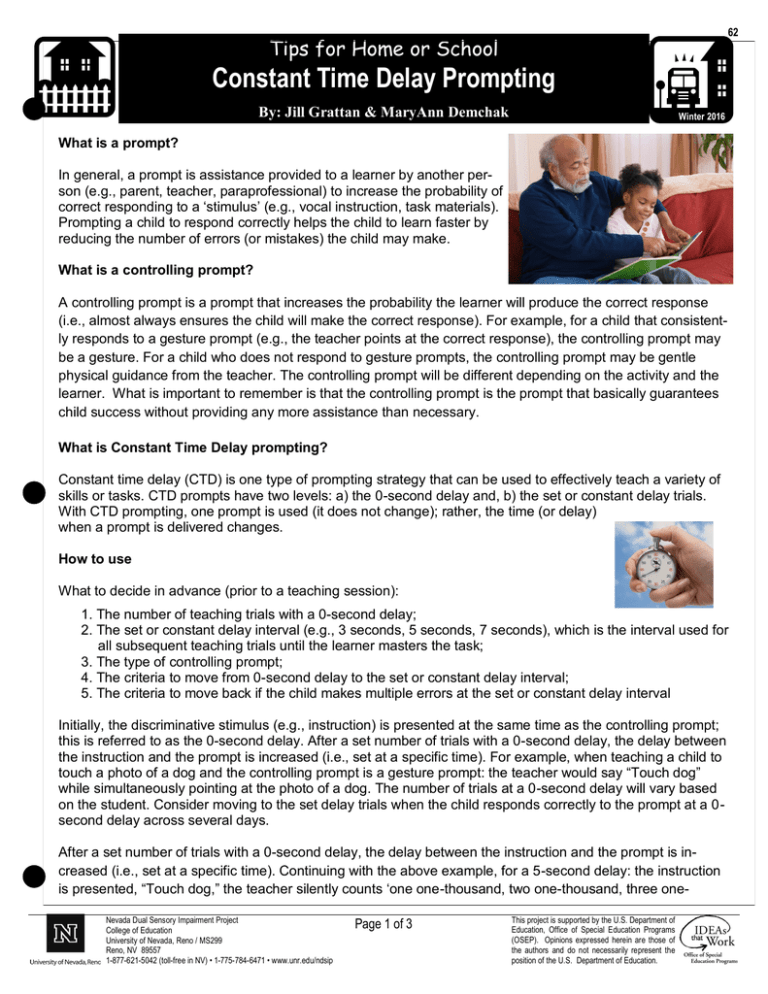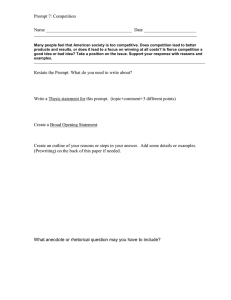Constant Time Delay Prompting
advertisement

62 Tips for Home or School Constant Time Delay Prompting By: Jill Grattan & MaryAnn Demchak Winter 2016 What is a prompt? In general, a prompt is assistance provided to a learner by another person (e.g., parent, teacher, paraprofessional) to increase the probability of correct responding to a ‘stimulus’ (e.g., vocal instruction, task materials). Prompting a child to respond correctly helps the child to learn faster by reducing the number of errors (or mistakes) the child may make. What is a controlling prompt? A controlling prompt is a prompt that increases the probability the learner will produce the correct response (i.e., almost always ensures the child will make the correct response). For example, for a child that consistently responds to a gesture prompt (e.g., the teacher points at the correct response), the controlling prompt may be a gesture. For a child who does not respond to gesture prompts, the controlling prompt may be gentle physical guidance from the teacher. The controlling prompt will be different depending on the activity and the learner. What is important to remember is that the controlling prompt is the prompt that basically guarantees child success without providing any more assistance than necessary. What is Constant Time Delay prompting? Constant time delay (CTD) is one type of prompting strategy that can be used to effectively teach a variety of skills or tasks. CTD prompts have two levels: a) the 0-second delay and, b) the set or constant delay trials. With CTD prompting, one prompt is used (it does not change); rather, the time (or delay) when a prompt is delivered changes. How to use What to decide in advance (prior to a teaching session): 1. The number of teaching trials with a 0-second delay; 2. The set or constant delay interval (e.g., 3 seconds, 5 seconds, 7 seconds), which is the interval used for all subsequent teaching trials until the learner masters the task; 3. The type of controlling prompt; 4. The criteria to move from 0-second delay to the set or constant delay interval; 5. The criteria to move back if the child makes multiple errors at the set or constant delay interval Initially, the discriminative stimulus (e.g., instruction) is presented at the same time as the controlling prompt; this is referred to as the 0-second delay. After a set number of trials with a 0-second delay, the delay between the instruction and the prompt is increased (i.e., set at a specific time). For example, when teaching a child to touch a photo of a dog and the controlling prompt is a gesture prompt: the teacher would say “Touch dog” while simultaneously pointing at the photo of a dog. The number of trials at a 0-second delay will vary based on the student. Consider moving to the set delay trials when the child responds correctly to the prompt at a 0second delay across several days. After a set number of trials with a 0-second delay, the delay between the instruction and the prompt is increased (i.e., set at a specific time). Continuing with the above example, for a 5-second delay: the instruction is presented, “Touch dog,” the teacher silently counts ‘one one-thousand, two one-thousand, three oneNevada Dual Sensory Impairment Project College of Education University of Nevada, Reno / MS299 Reno, NV 89557 1-877-621-5042 (toll-free in NV) • 1-775-784-6471 • www.unr.edu/ndsip Page 1 of 3 This project is supported by the U.S. Department of Education, Office of Special Education Programs (OSEP). Opinions expressed herein are those of the authors and do not necessarily represent the position of the U.S. Department of Education. thousand, four one-thousand, five,’ when the teacher reaches 5, he/she presents the prompt (e.g., gesture prompt). This delay between the instruction and the prompt, allows the child an opportunity to respond independently. However, if he or she does not respond, the prompt will still be provided. The length of the increase between the instruction and the prompt, is dependent on the child and the task; it is generally set between 4-5 seconds. If your child requires longer processing times, the delay may be increased. The key is to have the delay between the instruction and the prompt remain constant. Differentially reinforce prompted and independent responses – that is, provide more or bigger reinforcement for independent responses (i.e., when the child beats the prompt) and smaller or lesser quality reinforcement for prompted responses (i.e., when the child responds correctly to the prompt provided). Types of responses: 1. Correct responses before the prompt (i.e., child ‘beats’ the prompt) – provide more or bigger reinforcement 2. Correct responses after a prompt was provided – provide lesser or smaller amounts of the reinforcer 3. If the child responds incorrectly before the prompt – provide error correction (e.g., informational “No”) and move to the next trial. 4. If the child does not respond or responds incorrectly after the prompt - provide error correction (e.g., informational “No”) and move to the next trial. If the child makes several consecutive errors, consider changing the set delay time. For example, if the child correctly responds to prompts at the 0-second delay, however, consistently responds incorrectly at the 5-second delay – consider changing the set delay to 2-seconds and increasing the time between the instruction and the prompt when the child is successful. Example 1 of using CTD to teach a child to identify a dog in response to the instruction, “Touch dog.” For this example, the constant prompt delay is set at 3-seconds (remember, the maximum delay can vary based on learner needs and the task) The controlling prompt is a gesture (point) prompt. The criteria to move to the next delay level is: responds correctly to prompt 100% of opportunities across two days Delay level 0-second delay What the teacher does Child response Instruction and prompt are presented at the same time (say: “Touch dog” pointing at the photo of the dog). Child points to the photo of the dog 3-second delay Instruction presented “Touch dog” then teacher silently counts (“One one-thousand, two one-thousand, three”). When teacher says “3,” the teacher points to the photo of the dog. Child points to the photo of the dog Nevada Dual Sensory Impairment Project Page 2 of College of Education University of Nevada, Reno / MS299 Reno, NV 89557 1-877-621-5042 (toll-free in NV) • 1-775-784-6471 • www.unr.edu/ndsip 3 Initially, child points to photo after the prompt; eventually, she points to the photo before the prompt. This project is supported by the U.S. Department of Education, Office of Special Education Programs (OSEP). Opinions expressed herein are those of the authors and do not necessarily represent the position of the U.S. Department of Education. Criteria to move to next level Responds correctly to prompt 100% of opportunities across two days, move to next prompt level Example 2 of using CTD to teach a child to read the sight word ‘stop’ For this example, the constant prompt delay is set at 5-seconds (remember, the maximum delay can vary based on learner needs and the task) The controlling prompt is a vocal prompt. The criteria to move to the next delay level is: responds correctly to prompt 100% of opportunities across two days Delay level What the teacher does Child response 0-second delay Instruction and prompt are presented at the same time – the teacher holds up the written word ‘stop,’ and immediately reads, “Stop.” The written word ‘stop’ is held up then teacher silently counts (“One onethousand, two one-thousand, three onethousand, four one-thousand, five”). When teacher counts ‘5,’ the teacher reads the word, “Stop.” Child reads, “Stop” 5-second delay Criteria to move to next level Responds correctly to prompt 100% of opportunities across two days, move to next prompt level Child reads, “Stop” Initially, reads the word after the prompt; eventually, she reads the word before the prompt What can CTD be used to teach? Research indicates CTD can be successfully used to teach a wide variety of skills (this list is not comprehensive) from selfhelp skills, to functional life-skills (e.g., shopping), to social skills, to academic skills (e.g., number recognition), etc. References Walker, G. (2008). Constant and progressive time delay procedures for teaching children with autism: A literature review. Journal of Autism and Developmental Disorders, 38, 261-275. Wolery, M., Holcombe, A., Cybriwsky, C., Doyle, P. M., Schuster, J. W., Ault, M. J., & Gast, D. L. (1992). Constant time delay with discrete responses: A review of effectiveness and demographic, procedural, and methodological parameters. Research in Developmental Disabilities,13, 239-266. Nevada Dual Sensory Impairment Project Page 3 of College of Education University of Nevada, Reno / MS299 Reno, NV 89557 1-877-621-5042 (toll-free in NV) • 1-775-784-6471 • www.unr.edu/ndsip 3 This project is supported by the U.S. Department of Education, Office of Special Education Programs (OSEP). Opinions expressed herein are those of the authors and do not necessarily represent the position of the U.S. Department of Education.

